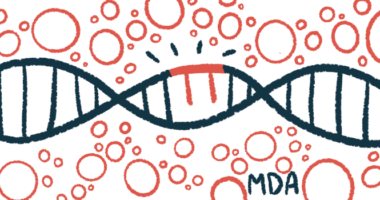Elijah Stacy Shares 13 Life Lessons in Book About Experience With DMD

Elijah J. Stacy giving a speech. (Courtesy of Elijah J. Stacy)
Author and advocate Elijah J. Stacy is using what he has learned through adversity in battling Duchenne muscular dystrophy (DMD) to help others overcome their own challenges.
DMD is a progressive muscle wasting disease that slowly robs a person’s muscle strength. In Stacy’s case, he lost the ability to walk in fourth grade and has limited use of his arms.
In September, the 20-year-old published his first book, “A Small If,” which contains 13 lessons he’s learned through dealing with Duchenne, starting a nonprofit to fund research to cure it, and losing his younger brother Max to the disease.
“I want people to read this book, and I want them to overcome their adversity,” said Stacy, who lives in Riverside, California, in a video interview with Muscular Dystrophy News Today.
Stacy, showing what’s possible despite having a degenerative muscle condition, is busy with public speaking engagements to raise awareness about DMD and educate students about the life lessons in his book. He’s also running his foundation, Destroy Duchenne, which he launched in 2017 at the age of 15.
The book’s title comes from Stacy’s attempt to avoid scoliosis surgery, which would have required doctors to insert a metal rod to help straighten his spine. Stacy’s neurologist gave him “a small if,” that if he did physical therapy, he might be able to correct the curvature.
Stacy writes that it took a lot of hard work and discomfort to succeed enough so that surgery was no longer required.
It is important to note that Stacy’s experience was unique; what worked for him in terms of treating his scoliosis and losing weight is not what’s recommended for DMD patients, according to Celina Jones, a physical therapist for the DMD Program at UMass Memorial Medical Center, which sees hundreds of patients with the condition. Some exercises he writes about, such as sit-ups, adaptive push-ups (done from one’s knees), and repeatedly getting up from the floor, may cause muscle damage in DMD patients.
Low-intensity exercise is important, Jones says, to maintain range of motion and limit muscle contractures; however, some exercises mentioned in the book could be harmful because they are eccentric muscle movements, or those that contract and lengthen muscles at the same time and go against gravity. Examples include descending stairs, bicep curls, or lowering oneself to the floor.
“Our goal with exercise is no use is disuse,” Jones said. “If you’re able to walk and you’re able to move around, but instead you don’t, you’re going to lose your strength.”
And when doing safe exercises such as walking short distances, swimming, or playing with friends, it’s important that the patient or guardian monitor for muscle soreness, fatigue level, pain, and rhabdomyolysis, a dangerous condition in which damaged muscles release proteins and electrolytes into the blood, which can cause organ damage.
Stacy said he talked to his doctor about the exercises, and they ultimately decided that it was better to strengthen the muscles he was able to use. When he went to physical therapy for his scoliosis, his therapist recommended core exercises, like eccentric sit-ups.
Stacy’s experience in overcoming scoliosis surgery helped inform his first lesson of the book: “defeating the odds” by visualizing accomplishing the goal, focusing on the task at hand, and working hard.
He said each lesson (there’s one for each of the 13 chapters) has its own importance, but specifically for those with muscular dystrophy or any type of disability, he believes that chapter nine’s “economy of control,” an ancient idea coined by Stoic philosophers, ranks high.
“There’s a lot of things that are not within our control, but we don’t need to worry about that; we need to focus on what we can do,” Stacy said.
Reversing his scoliosis isn’t the only difficulty he has had to surmount, as he also experienced the suffering of his own brothers. Max had a number of difficulties after his birth, including a heart defect; severe brain damage, which made him blind; and as they learned much later, DMD. He died when he was 14.
Stacy has another brother with the disease, Kai, 14, which means he has had to experience the progressive nature of the disease in another family member. Much of the book, however, is devoted to Stacy’s personal challenges — like suffering from a fracture, losing his ability to throw a football or basketball, and being teased at school for the way he walked.
It also devotes a handful of pages to describing Stacy’s impetus for starting Destroy Duchenne, whose mission is to cure DMD through gene editing and gene therapy.
In one of Stacy’s high school classes, he learned about CRISPR-Cas9, which allows scientists to directly cut and alter a person’s genes. Stacy also read a book on the subject by Samuel H. Sternberg and Jennifer A. Doudna, PhD, who shared a Nobel Prize and was one of the first scientists to help develop the technology that manipulates DNA.
“I was like, wow, OK, this stuff is real. It’s not just like science fiction,” Stacy said.
Seeing the promise behind it, he started raising money for that specific approach as a potential Duchenne treatment, in addition to other methods that would deliver a full-length dystrophin protein to a person’s cells. Lack of this protein causes the disease.
“Kids are literally the future of our world,” Stacy said. “And I think, well, can I make the world a better place for them? Can I make it to where some 6-year-old kid won’t have to end up in a wheelchair?”
So far, Destroy Duchenne has raised more than $100,000 through donations and some in-person events, such as a Bowling Battle fundraiser in Riverside, held before the COVID-19 pandemic. Stacy’s other goal for the organization is to raise awareness for the disease because without people knowing about it, there’s no way they can help.
“When I die, I want people to be like, ‘This guy gave me his all. This guy cared about people, he sacrificed his ego. He talked about real stuff. He truly cared about people. He answered the phone at two o’clock in the morning,’” Stacy said. “That’s what I want people to remember about me.”








